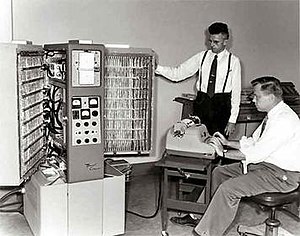Bendix G15

Bendix G-15, 1956
|
|
| Developer | Harry Huskey |
|---|---|
| Manufacturer | Bendix Corporation |
| Type | computer |
| Release date | 1956 |
| Introductory price | US$49,500 (Base system without peripherals) |
| Discontinued | 1963 |
| Units sold | 400 |
| Dimensions | 5 by 3 by 3 ft (1.5m by 1m by 1m) |
| Weight | 950 lb (450 kg) |
The Bendix G-15 computer was introduced in 1956 by the Bendix Corporation, Computer Division, Los Angeles, California. It is about 5 by 3 by 3 ft (1.5m by 1m by 1m) and weighs about 950 lb (450 kg). The base system, without peripherals, cost $49,500. A working model cost around $60,000 (over $500,000 by today's standards). It could also be rented for $1,485 per month. It was meant for scientific and industrial markets. The series was gradually discontinued when Control Data Corporation took over the Bendix computer division in 1963.
The chief designer of the G-15 was Harry Huskey, who had worked with Alan Turing on the ACE in the United Kingdom and on the SWAC in the 1950s. He made most of the design while working as a professor at Berkeley, and other universities. David C. Evans was one of the Bendix engineers on the G-15 project. He would later become famous for his work in computer graphics and for starting up Evans & Sutherland with Ivan Sutherland.
The G-15 was inspired by the Automatic Computing Engine (ACE). It is a serial-architecture machine, in which the main memory is a magnetic drum. It uses the drum as a recirculating delay line memory, in contrast to the analog delay line implementation in other serial designs. Each track has a set of read and write heads; as soon as a bit was read off a track, it is re-written on the same track a certain distance away. The length of delay, and thus the number of words on a track, is determined by the spacing of the read and write heads, the delay corresponding to the time required for a section of the drum to travel from the write head to the corresponding read head. Under normal operation, data are written back without change, but this data flow can be intercepted at any time, allowing the machine to update sections of a track as needed.
...
Wikipedia
